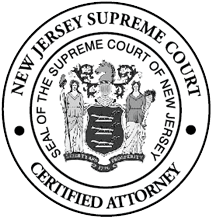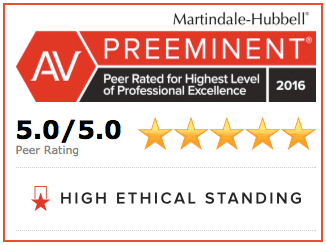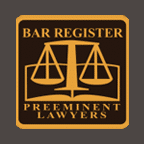Medical Chart Falsification
Read a short seminar written by Louis J. DeVoto about medical chart falsification and what to do when it happens.
MEDICAL CHART FALSIFICATION-
HOW CAN YOU STOP THE FRAUD?
By: Louis J. DeVoto, Esq.
September 17, 1999
I. INTRODUCTION
The National Head Injury Foundation estimates that approximately two million Americans will suffer a traumatic brain injury every year.1 Mild head injury accounts for 75% or more of those brain injuries.2 Data from many studies suggest that the most frequent exposure associated with brain injury is transport, i.e., automobiles, trucks, bicycles, motorcycles and watercraft.3 4 5
Unfortunately, persons surviving mild traumatic brain injuries are often victimized because little or no medical documentation of the head injury is entered at or near its onset.6 This non-documentation of the head trauma creates a “false medical chart”, that is, falsification of the medical chart, for the brain-injured patient that creates the recipe for later medical and legal mistreatment.
Therefore, the primary purpose of this paper is to provide health care providers with specific guidelines as to how to properly and accurately document the medical chart. Furthermore, the second purpose is to show how incomplete and inaccurate medical records adversely affect the legal claim of a brain-injured person.
Continue reading to learn more about the case of medical chart falsification.
II. CASE EXAMPLE OF MEDICAL CHART FALSIFICATION
The following example will serve to illustrate some problems typically encountered by an attorney representing persons suffering from a traumatic brain injury.
JOHN, Age 54
John is a passenger in a side-impact car crash. In fact, he denies losing consciousness at the scene and is taken by ambulance to the local emergency department. However, John complains to the nurse about neck and back pain and tells her he believes he struck his head on the door frame. Moreover, he has a headache and feels woozy. Then, X-rays are taken of his neck and back and a CT scan is taken of John’s head. However, all test results are negative.
John is discharged for further care to a local orthopedic surgeon and told to contact the emergency room if his headaches persist and/or if he vomits. Moreover, he is told to take Advil for pain. Also, there is a brief note in the hospital chart that John complained of a headache.
Then, John waits five days to see the doctor and tells him that his neck and back hurt and that he has headaches, getting less severe. However, since the CT scan was negative and because his headaches were not severe, the doctor assumes they’re attributable to his neck injury. Moreover, John is treated for his neck and back injury, and nothing further is done for his head. But, the doctor’s progress notes do not mention John’s head injury.
Something is Still Wrong
Three months later, John and his wife consult with an attorney and during this interview, the attorney learns from John’s wife that John has “not been himself” since the accident. In fact, he’s irritable, does not sleep soundly, has a loss of appetite, and is forgetful. So, they attributed these symptoms to the stress caused by John’s neck and back pain.
However, John’s attorney, believing that John may have a head injury, refers John to a neuropsychologist who tests John and diagnoses him with a mild traumatic brain injury. But, the neuropsychologist did not treat John, nor did he refer him for treatment. Also, he saw John again to confirm his prior testing shortly before the trial.
After that, John’s attorney hires a rehabilitation specialist who opines that John needs special care to help him throughout his lifetime and opines that hundreds of thousands of dollars of future care are needed to make John whole. So, at trial, the jury finds against John, finding that he was overreacting and exaggerating his brain injury.
III. WHY WERE THE JURORS SKEPTICAL OF JOHN’S REAL BRAIN INJURY?
Juries are smarter and more sophisticated than ever before. Like most Americans, juries will typically believe what they see, before they believe what they hear.7 Unfortunately, and all too often, diagnostic testing is negative in traumatic brain injury cases.8 In John’s case, the following medical history was present and lead jurors to be skeptical toward his mild traumatic brain injury:
- No foreign material in brain.
- No x-ray evidence of fracture of skull.
- Negative MRI/CT scan of brain
- No bleeding
- No loss of consciousness
- Also, no seizures
- No coma
- Patient looks good
- Lawyer and not doctor makes referral to neuropsychologist
- No follow-up treatment after diagnosis by neuropsychologist
In fact, all of this could have been avoided. Moreover, medical practitioners can make a difference for brain injured persons through clear and accurate medical chart documentation. Additionally, it’s good medical practice, and it greatly assists a brain injured patient’s legal case and it is something juries want to see to convince them that the injury is “for real”. In short, it’s the credible evidence that builds the juror’s trust and allows them to adequately compensate John and others like him.
IV. ACCURATE MEDICAL CHART DOCUMENTATION
The patient’s record is a legal document.9 Therefore, it must be presented completely, concisely, and accurately. Moreover, it is the building block for the brain-injured patient’s entire medical and legal care. In fact, time spent in the interview process gathering detailed information about the patient will prevent time-consuming errors and mistreatment. Additionally, it is the first step in the process of defining problems.10 11
A. Patient’s History found in Medical Chart
In fact, a patient’s history should document current health problems, past medical history, family medical history, and contain a profile of patient’s social life and well-being. However, the most important aspect of an interview of a person with a suspected brain injury, and one which is often overlooked, is the manner in which the interview conducted.12 This is the way it should be done:
1. Provide privacy for the patient.
2. However, do not look hurried.
3. Listen.
4. Then, probe for details.
5. But, do not cut off the conversation.
6. Moreover, get additional information and records.
7. Lastly, look for signs and symptoms 13 of brain injury.
- Headaches
- Memory problems, forgetfulness
- Concentration and attention problems
- Personality change
- Difficulty organizing tasks, planning the day, preparing meals and/or organizing activities
- Fatigue
- Inability to fall asleep or sleep soundly
- Dizziness, loss of balance
- Irritability, frustration, “short fuse”
- Bright lights are bothersome
- Speech and communications problems, (lost words)
- Depression
- Loss of smell, taste, hearing.
A.a. Ask Questions
8. Ask specific questions in follow-up to a patient’s complaints:
- How often do you forget details of recent events? (Get examples.)
- Also, how often do you forget details of conversations?
- Moreover, how often do you forget people’s names?
- Do you misplace objects?
- Do you lose your train of thought?
- How often do you have difficulty thinking of the words you want to use?
- Then, how difficult is it for you to organize your thoughts?
- Do you find yourself getting lost while driving or walking to frequently traveled places?
- Do you have difficulty completing chores or projects?
- Are you easily distracted?
- Or, do you have difficulty paying attention to more than one thing at a time?
- Are you having difficulty making simple decisions?
- Do you find yourself misunderstanding what people say to you?
- Or, do you have problems listening to people when there is competing noise?
- Do you find yourself showing up for appointments at the wrong time or on a wrong day?
- Are you having difficulty comprehending and remembering what you read?
- Have you noticed a decline in your spelling or writing skills?
- Do you have trouble with math or with handling money?
- Are you having difficulty with prioritizing and with time management?
- Also, are you feeling overwhelmed and disorganized?
B. Physical Examination
- Corroborate history
- Then, observe and document findings in the patient’s chart
- Finally, obtain objective information
C. Testing 14
1. X-rays
2. CT scans (Computerized Tomography)
3. MRI’s (Magnetic Resonance Imaging)
4. PET scans (Positron Emission Tomography)
5. SPECT Scans (Single Photon Emission Computerized Tomography)
6. EEG (Electroencephalography)
7. Evoked potentials
8. Neuropsychological testing
D. Diagnose and Treat or Refer for Treatment
Once the diagnosis of traumatic brain injury is made, the physician must treat the patient or refer the patient for treatment if it is needed. Therefore, jurors have a difficult time believing that someone has a brain injury yet has failed to get treatment.
While treatment should be individualized after a patient’s particular problems are diagnosed, a comprehensive assessment of neuropsychological functioning typically includes:15
- Firstly, assessment of attention, memory, language, visuospational skills, executive cognitive abilities and emotional behavioral and other psychological factors.
- Then, assessment of the individuals everyday function.
- Thirdly, assessment of relationship between the individuals neuropsychological functioning or his or her everyday functioning.
- Treatment:
Firstly, attention training.
• perception and execution
• speed of response
Secondly, memory and learning retention.
• memory notebook
Thirdly, language therapy.
• certified speech pathologist
Then, visuospatial therapy
• visual fields
• visual scanning
Lastly, sensory-motor therapy
• Progress Notes: Must be complete and accurate and document patient’s problems and struggles on a day-to-day basis.
V. HOW AN ATTORNEY CAN USE A PROPERLY DOCUMENTED MEDICAL CHART
In fact, an attorney can use a well-documented medical chart to motivate jurors and to help brain-injured victims receive full and complete compensation for their injuries. The attorney must also personally speak to each EMT, police officer, and rescue personnel and review their records. Witnesses who can testify to the person’s condition before and after the injury must also be thoroughly interviewed. Therefore, the more accurate the corroboration is, the more credible the patient will be. There is nothing so tragic as to have a brain injured person, with real injuries, have his or her medical and legal case taken lightly because of inaccurate early reporting and documentation. Hopefully, we can all work towards educating those responsible to help bring about changes. Moreover, the attached Appendix shows some examples of how powerful the medical chart can be at trial.
CONCLUSION OF MEDICAL CHART FALSIFICATION
To conclude, successful legal representation of persons with brain injuries does not require a leap of faith by juries. Effective medical chart documentation and treatment is the first and perhaps the most important step in helping those with brain injuries. Therefore, from a medical perspective, it helps the patient get the appropriate care and from a legal perspective, the jury gains trust in the patient, the injury and the medical experts.
All in all, hopefully, this short seminar will be of help if you ever find yourself in the same situation; where there is a medical chart falsification.
ENDNOTES
1. White & Lakavec, The Diagnosis and Management of Head Injury, 327, 15 New. Eng. J. Med. 1507.
2. Kraus, JF & Nourjah P., The Epidemiology of Mild Uncomplicated Brain Injury, J Trauma 28:1637-1643, 1988.
3. Annegers JF, Grabow JD, & Kurland LT, The Incidence, Causes and Secular Trends of Head Injury in Olmstead County, Minnesota, 1935-74; Neurology 30:912-919, 1980.
4. Cooper KD, Tabaddos K, & Hauser WA, The Epidemiology of Head Injury in the Bronx, Neuroepidemiology 2:70-88 (1983).
5. Kraus JF, Epidemiology of Head Injury, Cooper, P (ed) Head Injury, 3rd rev. Baltimore, Williams and Wilkens 1992.
6. Evans, Neurology and Trauma, Epidemiology of Brain Injury, P. 3, WB Saunders (1996).
7. Starr VH & McCormick M, Jury Selection, Second Edition (1990).
8. Leven HS & Eisenberg HM, Computed Tomography and Magnetic Resonance Imaging in Moderate Head Injury, Oxford Univ. Press, New York (1989).
9. N.J. Admin. Code, Title 8:43
G, Medical Records Patient Services, § 15.3; Also, Medical Record Quality Assurance Methods, § 15.7; Medical Records Policies and Procedures, § 15.2; Medical Records Staff Qualifications, § 15.5; (1990).
10. JCAHO Accreditation Manual for Hospitals, Vol. 1; Standards for Medical Record Entries, JM. 7.1-7.8 (1996).
11. Haggard BA, Coping with Anxiety about Patient Interviews, AORN J, 1983 Feb; 37(2):195-198.
12. Manual of Nursing Practice, Data Collections and Record Keeping, J.B. Lippencott Company, (4th Ed. 1986).
13. Evans, RW, Postconcussion Syndrome and the Sequelae of Mild Head Injury, Neurology and Trauma, Table 5-1, P. 93, WB Sanders Co. (1996).
14. Evans, RW, Postconcussion Syndrome and the Sequelae of Mild Head Injury, Neurology and Trauma, P. 100-103, WB Sanders Co. (1996).
15. Malec JF, Cognitive Rehabilitation, Neurology and Trauma, P. 231-234, WB Sanders Co. (1996).









